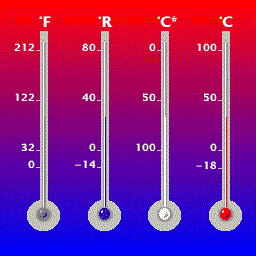
Various physicists worked on the problem of quantitative temperature measurement, and in the first half of the 18th century some 35 different scales had been proposed. The most successful of these were
The Celsius scale was originally simply known as the centigrade scale. It was later inverted so that the melting point of ice is at 0°C and the boiling point of water at 100°C, and in that form it was renamed in 1948 the Celsius scale. It is used in most countries of the world and is the standard temperature scale in science.
William Thomson (later Lord Kelvin) introduced the absolute temperature scale, now known as kelvin, which uses the Celsius scale but starts at absolute zero (0 kelvin = -273.15° Celsius).
The Réaumur scale was discontinued in the 20th century. The Fahrenheit scale was used in most English-speaking countries until about 1970 in slightly adjusted form where the boiling point of water at normal atmospheric pressure is set to 212°, giving a normal body temperature of 98.6°F. It is still in use in the United States of America.

A comparison of the three major temperature scales